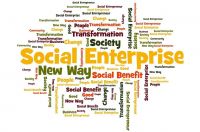
来源 | CONSCIOUS COMPANY
2017年摩拜单车入围首届“中国社会企业奖”时引起全社会广泛讨论,之后美团创始人王兴也宣称“美团要成为一家社会企业”。“到底什么是社会企业?”这个听上去很美好的范式有哪些判断标准?
本文作者妮可·莫特(Nicole Motter) 是“社会创新战略”咨询公司(Social Innovation Strategies)的创始人,也是影响力投资顾问和律师。她通过社会企业图谱向我们展示了六种“公益与美好商业”相结合的不同形态。
一般来说,“社会企业”意味着利用商业手段来解决社会问题。这个概念可以与“社会创新”重合,也可能不重合。
“社会创新”意味着以一种新的、突破性的方式来解决社会需求。可以使用商业工具也可以不使用商业工具进行创新。
但这一领域的典范人物却在这两个概念的交叉点上开展工作。
然而对于大多数人来说,“社会企业”最终成为涵盖这两个概念的宽泛的默认用语。不管怎样,这种扩大化让这个词越来越受欢迎(好比水桶越大,你可以扔进去的东西就越多),但也导致了人们很难对它的定义达成一致。
一端是进行创业实践的小型非营利组织;另一端是进行环保实践,特别善待员工并/或将部分收益捐赠给慈善机构的大型主流公司。
机构的主要活动在多大程度上必须与其社会使命相联系?
实体的成立文件中是否有必要包括社会承诺?
与此同时,一些定义界定了重合的部分。总之很令人困惑。
作为一名社会企业顾问和律师,我花了很多时间思考如何理解人们称之为“社会企业”的各种组织。下面的图表展示了我是如何对这一行业进行分类的。
1. 创业型非营利组织
Entrepreneurial Nonprofit
这些组织是免税实体,至少有一部分是靠收入支持的(尽管也有小部分人认为,一个创新的非营利性组织即使没有收入也可以入选)。满足创业型非营利组织的条件需要 (a)开展创收项目,或(b)采用整体的创业型商业模式。
资金来源
它们的主要资金来源通常来自基金会的资助和公众的捐款(免税非营利模式的基石),尽管在某些情况下,也有银行贷款或基金会项目相关投资。
案例
“美国女童子军组织” (Girl Scouts of America,有合作食品售卖项目)和“每日餐桌”(Daily Table)以及“爱在洛杉矶”(Love L. A.),他们作为零售商为那些没有其他渠道的社区提供健康、实惠的食品。
2. 非非营利组织
Non-nonprofit
你没听说过?我并不惊讶——这是我为了澄清经常被忽视但有意义的概念区分自造的。
这些组织像非营利组织一样以社会使命为出发点,但在免税模式的限制之外运行——换句话说,它们是营利性企业。它们的存在主要是为了解决一个社会问题(使命优先或使命为中心),创造收入的活动与创造变革的活动交织在一起。
他们不以营利为目的,因为他们就在“营利”商业之中;进而,他们谋求更高的能力增长、可持续性、创新和风险承受——这些都是在其他领域非常成功的机构的组成部分——而不是通常税收减免政策所允许的。
资金来源
一模式理想的资金来源是基金会的项目相关投资,在关键的早期阶段提供低成本的资本,并防止为了今后的财务回报而损害最充分的使命表达。在某些情况下,也有基金会资助、传统的天使投资人或风险投资公司的投资。
案例
Everytable通过自创的变动售价商业模式,提供顶尖厨师制作的平价外带餐点来消除“食物沙漠”(初心来自于很多低收入家庭因为忙于工作经常给孩子购买不健康的快餐);
InvestED通过将教育科技和金融科技创造性地结合起来,向全球低收入的创业者开放投资渠道。
其他属于这一类别的企业包括“天才一代”(Generation Genius)、“Amplio招聘” (Amplio Recruiting)、“南丁格尔智能用药提醒” (Nightingale Apps)、Tickleberry Place、“迷你城市”(MiniCity)和Neopenda。
Socially Responsible Business
这是其中最大的一类,包括共益企业(benefit corporations)、获认证的共益企业(B Corps)以及所有双重和三重目标的企业。
虽然这些类型的机构可能主要是为了解决社会问题而创建的,但通常来说,这种分类是基于采用有利于社区、员工或环境的做法差异(通常与商业发展策略一致)。
在共益企业和获认证的共益企业的情况下,这种区分会被列入公司的组建文件中,同时会有一条规定,说明他们在法律上允许尊重这种区分(无论是公司文化、负责任的采购等),即使有可能以牺牲股东利润最大化为代价。
这里值得注意的是,共益企业是美国州一级认证的合法实体,而获认证共益企业是由第三方认证的营利性实体。双重目标是指在关注财务回报的同时关注社会价值,而三重目标则是指关注环境、社会和财务回报。
资金来源
这里的主要资金选择包括传统的天使投资和风险投资,以及在某些情况下的项目相关投资。
案例
THRIVE农夫咖啡(THRIVE Farmers Coffee),偏向于以使命为中心;
Ben & Jerry’s和Patagonia,偏向于建立更美好的企业。
4. 捐一获一/捐赠部分收益模式
Give One, Get One/DonatePortion of Proceeds Model
这些公司将其部分业务用于慈善工作,并且几乎总是被划分为前段和后端的类别(在上面图表的两边)。创造收入的活动通常与创造变革的活动是完全分开的,而且在很多情况下,社会部分是公司核心业务的附加部分。
因为这些模式通常会反哺到传统的非营利组织系统中,所以我把它分成了一个单独的类别。
资金来源同3
案例
“TOMS布鞋”、“瓦比派克眼镜公司” (Warby Parker)、“善行流传”(Good Spread)、“纽曼私传”(Newman’s Own)。
5.提高社会意识的品牌
Awareness Brand
虽然有些人会将这些概念扩大到几乎包括前两类中的所有内容,但我们认为,还有一种未被提及的不同类型的公司——这类销售产品的公司旨在吸引社区参与,提高人们对社会问题的认识,但其主营活动并不一定谋求解决社会问题的根源。
资金来源同上
案例
“每一度美好”(Beautifulin Every Shade)、“值得去爱”(So Worth Loving)。
6. 其他
Everything Else
没有一个放之四海而皆准的模式,也不是每个机构都能整齐划一地归入上述类别(特别是考虑到这个领域不断变化的性质)。社会企业雇用模式——利用企业为弱势群体提供有意义的工作和赋权(如Bitty and Beau’s Coffee),是一个可以纳入上述任何类别的组成部分。
还有像Fruitcraft (前身为加州果酒公司California Fruit Wine)这样的异类,它正在开创一种名为社会价值企业(Social Value Enterprise)的新模式。虽然不懂行的人可能会将其归类为社会负责任企业(上述第3类),但Fruitcraft背后的人非常明确地追求更多——即利用市场力量来激励和奖励整体思考——他们声称有三个决定性的方面使社会价值企业自成一格。
员工有民主所有权,包括责任制和公司内部的决策权。
没有出售的可能性,使公司永久由员工管理,以造福社会。
释放100%的利润用于社会公益。
不要被标签所困
Don’t get caught up in the labels
虽然有很多选择,但说到底,标签并不重要,除了税收和法律方面的考虑(需要和专业人士探讨)。重要的是创造一些有意义的社会价值——无论你正在考虑的模式或商业想法是什么,无论它属于上述分类还是其他形式。
篇文章想传达的是:如果你内心深处有种想改变世界的冲动,那就想办法去做吧。我相信你最终会创造出美好的事业,并以一种只有你才能做到的方式增加社会价值。
英文原文阅读
A Look Inside the 6 Types of Social Enterprises
CONSCIOUS COMPANY
Jan 22, 2019
“What exactly is a social enterprise?” It’s a question that comes up a lot, probably because there isn’t a consensus. Generally speaking, “social enterprise” means using business tools to address a social need. This concept may or may not overlap with “social innovation,” which means addressing a social need in a new, groundbreaking way. While it’s possible to use business tools without using them innovatively, and it’s possible to innovate without using business tools, the poster child for this sector works at the intersection of these two concepts.
Yet for most people, “social enterprise” winds up being the broad, default phrase used to cover both concepts. For better or worse, that expansiveness has snowballed the term’s popularity (the bigger the bucket, the more stuff you can throw in there) but has also led to trouble agreeing on a definition.
The various “social enterprise” definitions can include some or all of a number of models: small nonprofits using entrepreneurial practices on one end of the spectrum; big, mainstream companies using environmentally sound practices, treating their employees particularly well and/or donating a portion of their proceeds to pre-existing charities on the other.
In the middle you’ll find other definitions, with plenty of debate over what belongs, including the degree to which an entity"s primary activities must tie to its a social mission, the necessity of including social commitment in an entity’s formational documents and whether aside-project of an existing organization should count as a “social enterprise.”Meanwhile, some definitions provide for overlap. Bottom line: it’s confusing.
As a social enterprise consultant and lawyer, I’ve spent a lot of time thinking about how to make sense of the various organizations we sometimes call “social enterprises.” The diagram below shows how I categorize the spectrum.
Nicole Motter’s Social Enterprise Spectrum
1. Entrepreneurial Nonprofit
These are tax-exempt entities supported, at least in part, by earned income (although I’ve seen it argued once or twice that an innovative nonprofit idea, even without earned income, makes the cut).To reach entrepreneurial nonprofit status, these organizations can either (a)implement a revenue-generating program or (b) adopt an overall entrepreneurial business model.
Funding
Their main funding sources typically are grants from foundations and donations from the general public (the cornerstone of the tax-exempt nonprofit model), although in some circumstances loans from banks, or from foundations in the form of program-related investments, are also possible.
Examples
Girl Scouts of America, with its much-loved cookie sale program, and Daily Table and With Love L.A., retail grocers bringing healthy, affordable food options to neighborhoods that don’t otherwise have access.
2. Non-nonprofit
Never heard of this one? I’m not surprised —I made it up, for the sake of clarifying often-overlooked yet meaningful distinctions. These organizations start with social mission, much like a nonprofit, and then figure out a way to make it work outside the restrictions of a tax-exempt model — in other words, they’re a for-profit business. They exist primarily to address a social issue (“mission-first” or“mission-centric”), with revenue-generating activities intertwined with change-making activities.
They don’t form as for-profits because they are in business “for profit”; rather, it’s a decision that allows for higher-capacity growth, sustainability, innovation and risk-taking — all components of highly successful entities in other sectors — than is generally permitted under the regulations that come with tax-exemption.
Funding
The ideal funding source here is program-related investments from foundations, which provide low-cost capital at a critical early stage and prevent compromising the fullest expression of mission for financial returns down the road. In some cases, grants from foundations or investments from traditional angel investors or venture capital firms also may be possible.
Examples
Everytable, seeking to eliminate food deserts through affordable grab-and-go meals with a first-of-its-kind sliding scale model; and InvestED, opening access to capital to low-income entrepreneurs globally with a creative combination of edtech and fintech. Others that fall in this category include Generation Genius, Amplio Recruiting, Nightingale Apps, Tickleberry Place, Mini City and Neopenda.
3. Socially Responsible Business
This is the biggest bucket of them all and includes benefit corporations, Certified B Corporations and all things double-and triple-bottom-line. While these types of entities can be created primarily to address a social issue, it’s more common that this categorical distinction is based on the adoption of practices benefiting community, employees or environment (generally more aligned with the idea of doing business better). In the case of benefit corporations and B Corps, this distinction is included in the company’s formational documents, along with a provision stating that they are legally permitted to honor this distinction (whether that be company culture, responsible sourcing, etc.), even at the expense of shareholder profit maximization.
Worth noting here is that benefit corporations are a legal entity formed at the state level, whereas B Corp is a certification available to other for-profit entities (such as corporations and LLCs). Double-bottom-line denotes a focus on social returns alongside financial ones, while triple-bottom-line denotes a focus on environmental, social and financial returns.
Funding
Primary funding options here include traditional angel investments and venture capital, as well as program-related investments in some circumstances.
Examples
THRIVE Farmers Coffee, on the more mission-centric side; Ben & Jerry’s and Patagonia, on the more build-a-better-business side.
4. Give One, Get One/Donate Portion of Proceeds Model
These companies direct some portion of their business toward charitable work and are almost always layered into the preceding and subsequent categories (falling on either side of it in the diagram above). Revenue-generating activities are generally wholly separate from change-making activities and, in many cases, the social component is an add-on to the company’s core business. Because these models generally feed back into traditional nonprofit system, I break it out as a separate subcategory.
Funding
Same as above
Examples
TOMS, Warby Parker, Good Spread, Newman’sOwn.
5. Awareness Brand
While some will expand these terms to include virtually everything in the previous two categories, we think they also capture a different type of company not yet mentioned — those that sell products designed to engage community and bring awareness to a social issue, but whose primary activities don’t necessarily address the root cause of the social problem they’re bringing awareness to.
Funding
Same as above
Examples
Beautiful in Every Shade, So Worth Loving.
6. Everything Else
There is no one-size-fits-all, and not every entity will fit neatly in these categories (particularly given the constantly evolving nature of this sector). The social enterprise employment model, which uses the business to provide meaningful work and empowerment to a disadvantaged population (like Bitty and Beau’s Coffee), is a component that can be layered into any of the categories discussed above
Then there’s outliers like Fruitcraft(formerly the California Fruit Wine Company), which is pioneering a new model called social value enterprise (SVE). While an untrained eye might classify this as a socially responsible business (group 3 above), the folks behindFruitcraft are very clear about striving for more — namely using market forces to incentivize and reward thinking about the whole — with three defining aspects they claim put SVE in a category of its own:
Democratic ownership by employees, including accountability and decision making within the company.
No possibility of sale, keeping the company permanently stewarded by the workforce for the benefit of society.
Unleashing 100 percent of profits for social good.
Don’t get caught up in the labels
While there are a lot of options out there, at the end of the day the label doesn’t really matter, except for those that have tax and legal considerations (talk with a professional about those). What matters is that you’re creating something meaningful — whatever model or business idea you’re considering, whether it’s one on this list or something else altogether.
The moral of the story: If you feel a tug from deep inside to do something good, just do. I bet you’ll wind up creating something beautiful and adding social value in a way that only you can.
*免责声明:本站文章图文版权归原作者及原出处所有 ,文章内容为作者个人观点,并不代表本网站。如果您发现网站上有侵犯您的知识产权的作品,请与我们取得联系,我们会及时修改或删除。




